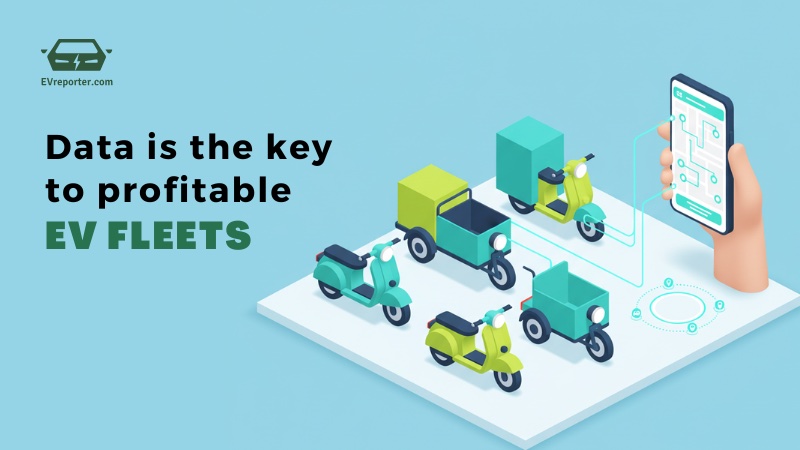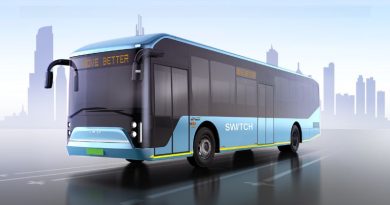Data is the key to building profitable EV operations and unlocking financing: Terniza Berry
TapFin has launched its AI-enabled data intelligence platform – ‘FleetForce’ for operators and “TAPFIN TRUST” for lenders. The platform enables users to better manage and track the performance of their assets by taking fragmented inputs and turning them into actionable intelligence.

Terniza Berry, Co-founder and COO at TapFin, discuss how timely, relevant, and easy-to-understand data access can help drive better ROI for EV fleet operators and build lender confidence.
What are the main pain points you identified for EV fleet operators, and which of these can be mitigated with access to data?
When we started two years ago, TapFin was built around the fleet operator at the core. We began with financing support through our fintech, which is now further strengthened by our wholly owned NBFC subsidiary – Go Green Capital. But we realised capital deployment in this ecosystem is limited because traditional underwriting doesn’t work for EVs. Here, data becomes critical.
Fleet operators—whether in last-mile delivery, people mobility, or urban logistics—face unpredictable revenues, downtime affecting margins, and limited financing options. With EVs, they’re often flying blind, unable to optimise performance or prove creditworthiness. At the same time, they are drowning in raw data from IoTs, BMS, GPS, etc., but without actionable insights.
The biggest challenges are lack of visibility on asset health, range anxiety, downtime from charging behavior, unpredictable maintenance, and limited visibility of driver behavior—compounded by multiple OEMs, fleet types, and form factors. With proper data tracking, many of these can be resolved: operators can monitor state of charge, predict battery degradation, get preventive maintenance alerts, and optimise routes. This improves reliability and reduces downtime. The advantage with EVs is that data doesn’t just highlight problems—it helps prevent them.
OEMs already provide data platforms to share data with fleet operators or asset owners. Why is there still a need for a platform like FleetForce to support fleet operators and lenders with their data needs?
For a fleet operator with multiple vehicles across various OEMs and form factors, data currently resides in siloed applications. There’s no consolidated view, and most operators still rely only on GPS for tracking. No existing platform builds an intelligence layer over this scattered data to give operators a unified view of fleet performance—that’s why we built FleetForce.
FleetForce is an AI-enabled data intelligence platform—agnostic to IoT type, technology, form factor, business model, or vehicle model.
When we spoke with customers, OEMs, lenders, and partners, everyone agreed: OEM platforms only provide data for their own assets, which is fragmented and lacks standardisation. Even consolidated data alone isn’t enough. FleetForce goes further by providing actionable intelligence— showing trends, risks, behaviors, and corrective steps. The idea is not just to supply insights but to enable operators to act on them.
How do you gather the data? Do you connect through APIs provided by different OEMs, or install hardware in vehicles to collect the data?
Since we’ve been in the ecosystem, we’ve been building partnerships with IoT providers, battery OEMs, and vehicle OEMs. Wherever APIs are available, we integrate directly and pull data. Where APIs are restricted or data isn’t standardised, we deploy lightweight IoT hardware to extract telemetry from CAN or BMS.
The goal is universal compatibility on a single unified interface, always with customer consent and data privacy in mind. For vehicles without IoT, such as some low-speed models, we also offer suitable IoT solutions bundled with our platform. Ultimately, the choice rests with the customer.
And what would the output look like? Can you provide an example of how these insights can help inform corrective action before issues become too costly?
The output comes in three ways:
- First is the dashboard, where risks are categorised with clear factors and corrective actions. It shows real-time or T+1 data and highlights immediate steps to mitigate risks.
- Second, we offer API integration with stakeholders’ existing systems—whether it’s a lender’s loan management interface or even simple Excel sheets. We can feed data into their systems or pull from them to generate insights.
- Third, we provide customizable reports in formats such as PDF or Excel, which can be scheduled as needed. Operators can run cohort or trend analyses.
The format and granularity of data vary from user to user. The platform provides flexibility, allowing each team to consume insights in a way that best supports their role. Operations teams may rely on dashboards for real-time SoC levels, vehicle availability, idle times, or driver performance. At the same time, promoters may prefer revenue-linked summaries, reports on fleet health or long-term battery degradation, which signals costly replacements ahead.
We map fleet data to the customer’s business model, ensuring that every insight directly reflects its revenue impact. For example, if the vehicles underperform, promoters don’t have to wait until the billing cycle or a client dispute—they can immediately anticipate the revenue shortfall. Similarly, if a vehicle goes out at 40% SoC (State of Charge), the resulting downtime translates directly into lost productive hours and reduced earnings.
For a fleet operator, how does access to this data improve ROI or profitability? What actions can they take to use the data for better margins and efficiency?
Data turns uncertainty into predictability—which drives profitability. Without data tracking, as seen over the past 2–3 years, vehicles often came back with failing batteries because operators had no visibility into battery health or degradation. Typically, batteries are discarded only after they stop performing, and there are few organised avenues for reuse or resale—leaving operators blindsided by costs.
With FleetForce, we track key asset metrics such as SoC and SoH. This allows operators to monitor battery degradation trends, receive alerts, and take corrective action early—extending battery life. For example, if a battery is at 85% SoH, the platform can project its performance six months ahead and suggest whether to redeploy it for a second life or recycle it.
Beyond batteries, data helps optimise charging, reduce idle time, improve routing, track energy consumption, and monitor driver behaviour. It also identifies underutilised assets. Together, these insights improve utilisation and cut losses, directly impacting the P&L. Every rupee saved or earned ultimately comes from data visibility.
At what scale does data tracking become essential for a fleet operator, given the associated costs? When should an operator start investing in it?
When building FleetForce, we assumed data tracking became necessary at 50–100 vehicles. However, in reality, manual oversight typically begins to break down much earlier—around 10–20 vehicles in smaller form factors, and even at 10 vehicles for larger ones.
With EV fleets, it’s not just about scale. Complexity increases with mixed fleets, multiple OEMs, and operations across geographies. OEM data sets don’t talk to each other, so without consolidation, visibility is lost. For a single-city fleet of 10 vehicles, manual management may work, but once you expand hubs or add variety in vehicles, data becomes essential.
It’s also critical when operators seek external financing or work with enterprise clients, who demand reliability in operations, repayments, and service standards. So, the need for data tracking is less about fleet size and more about the cost of errors, which is why it’s becoming indispensable.
For lenders, data tracking begins once a vehicle is deployed and operational. But when deciding whether to finance a particular asset or borrower, can data also support that decision?
In traditional lending, benchmarks evolved over decades through secondary markets and multiple credit cycles. EVs don’t have that history yet, but with FleetForce, lenders can access aggregated insights across similar cohorts—business models, OEMs, vehicle models, battery types, duty cycles, and geographies. This benchmark data gives a predictive view of utilisation, revenue potential, and repayment ability even before deployment. So, while an individual operator’s data only comes after disbursement, lenders are not flying blind—they’re basing underwriting on real-world performance patterns, which leads to smarter credit decisions.
For lenders, FleetForce supports both early warning signals and underwriting models. Traditionally, they track only financial risks, but operational risks—like vehicle utilisation or battery health—directly affect revenue with a lag. By providing these operational risk parameters in real time, we help lenders strengthen both monitoring and credit policies.
Financial data points typically reflect problems after they have occurred. However, by tracking operational patterns during usage, issues can be identified early and corrected before they have a financial impact.
Take a typical lending scenario: as long as repayments come on time, lenders see no red flags. But we can provide deeper insights. If an operator’s utilisation consistently stays at 85–90%, lenders know the business is healthy and can proactively offer up-sell opportunities. On the other hand, if utilisation is stuck at 20%, repayments may still be on track today, but it signals future credit risk. This allows lenders to engage with the operator early before it impacts repayment. So, data helps on both sides —identifying risks in advance and uncovering new growth opportunities.
Battery health is a key focus. What other parameters require constant monitoring?
Battery health is a key metric, but it is also an outcome influenced by several other factors, such as charging practices—voltage levels, depth of discharge, and charging frequency.
Ambient temperature also plays a role: batteries tend to degrade faster in hotter climates. Driver behaviour is another important factor – the way a vehicle is driven not only impacts battery life but also overall revenue. For instance, if a driver has excessive idle time during an 8-hour shift, it reduces billing efficiency. Routing choices affect both utilisation and costs—if drivers take longer detours to access familiar charging stations, it increases dead kilometres and reduces profitability.
The business model further influences what constitutes efficient utilisation. Parameters differ depending on whether the operator uses fixed or swappable batteries, two-wheelers for quick-commerce deliveries, or for e-commerce logistics. Each use case defines asset utilisation and revenue potential differently.
Preventive maintenance is also critical. EV warranties are generally linked to factors such as charging cycle count, mileage, and years of use. If a vehicle is charged improperly, driven inefficiently, or poorly maintained, the asset may degrade before the warranty period ends. This creates risks for lenders, who may be left with non-performing assets earlier than expected, and for OEMs, who may have to take warranty calls without sufficient diagnostic data.
Tracking these parameters—battery health, charging behaviour, driver usage, preventive maintenance, and business model fit—provides valuable insights not only for fleet operators but also for lenders, OEMs, and, in the future, insurers. It allows each stakeholder to better manage risks, ensure compliance with warranties, and identify opportunities for improved utilisation and profitability.
OEMs need to decide where to market a particular vehicle model, how to deploy sales resources, and where they can realistically gain market share. Insights like which vehicle model, form factor, or technology performs best in a given city or under a specific business model become valuable benchmark data for all stakeholders—OEMs, operators, and lenders alike.
This Interview was first published in EVreporter Sept 2025 magazine.
Also read: Driving last-mile logistics with electric vehicles in India | Stakeholder discussion
Subscribe today for free and stay on top of latest developments in EV domain.






